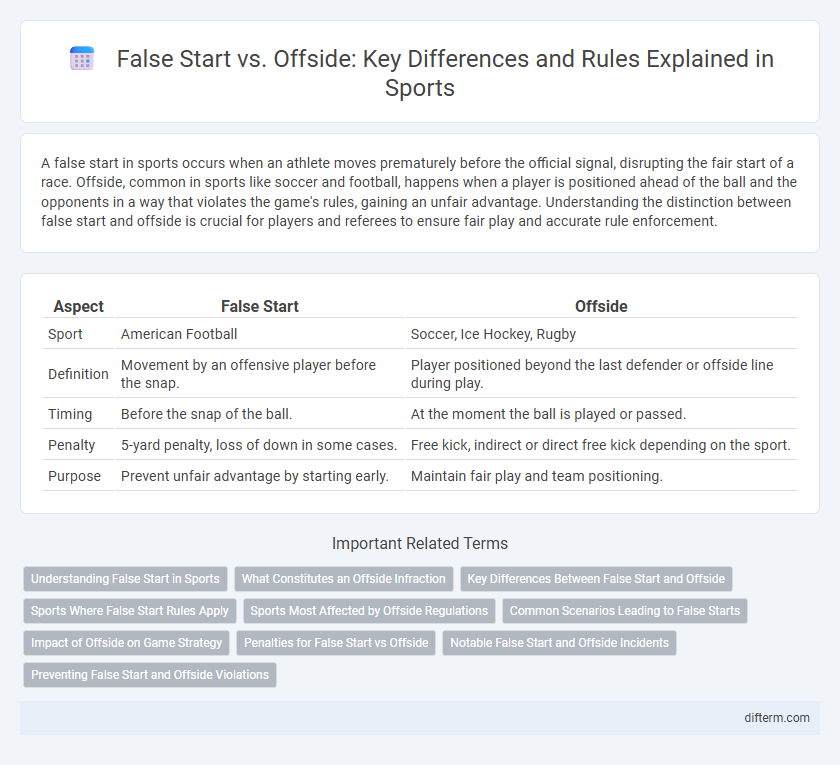A false start in sports occurs when an athlete moves prematurely before the official signal, disrupting the fair start of a race. Offside, common in sports like soccer and football, happens when a player is positioned ahead of the ball and the opponents in a way that violates the game's rules, gaining an unfair advantage. Understanding the distinction between false start and offside is crucial for players and referees to ensure fair play and accurate rule enforcement.
Table of Comparison
| Aspect | False Start | Offside |
|---|---|---|
| Sport | American Football | Soccer, Ice Hockey, Rugby |
| Definition | Movement by an offensive player before the snap. | Player positioned beyond the last defender or offside line during play. |
| Timing | Before the snap of the ball. | At the moment the ball is played or passed. |
| Penalty | 5-yard penalty, loss of down in some cases. | Free kick, indirect or direct free kick depending on the sport. |
| Purpose | Prevent unfair advantage by starting early. | Maintain fair play and team positioning. |
Understanding False Start in Sports
A false start in sports occurs when an athlete begins movement or action before the official signal, causing the play to be stopped and penalized. This violation is common in track and field, where runners may twitch or start early, and in American football, where offensive players move illegally before the snap. Distinguishing a false start from an offside is crucial; offside involves being beyond a designated line prior to play initiation, whereas false start is premature motion itself.
What Constitutes an Offside Infraction
An offside infraction occurs when a player is positioned closer to the opponent's goal line than both the ball and the second-last defender at the moment the ball is played, violating game rules designed to prevent unfair advantage. Unlike a false start, which happens in sports like track and field when an athlete moves prematurely before the official signal, offside is specific to team sports such as soccer, rugby, and American football. Officials use precise positioning and timing to determine offside, ensuring fair play and adherence to the rules governing player movement and positioning.
Key Differences Between False Start and Offside
False start occurs when a player moves before the official signal to begin a play, commonly seen in track events and American football, leading to an immediate penalty. Offside is a positional infraction primarily in soccer, rugby, and hockey, where a player is ahead of the last defender or before the ball is played, resulting in a stoppage of play and a free kick or scrum. The key difference lies in the timing and spatial context: a false start relates to premature motion before a start command, while offside concerns a player's positioning relative to opponents during active play.
Sports Where False Start Rules Apply
False start rules apply primarily in track and field events such as sprinting, where athletes must remain motionless until the starting signal is given to avoid disqualification. In contrast, offside rules are specific to team sports like soccer, football, and hockey, regulating player positioning relative to opponents before the ball or puck is played. Understanding the distinctions is crucial for athletes and officials to enforce fair play and maintain competitive integrity.
Sports Most Affected by Offside Regulations
Offside regulations critically impact sports like soccer, hockey, and rugby, where player positioning directly influences game flow and scoring opportunities. In soccer, the offside rule prevents attackers from gaining unfair advantage by staying behind the last defender when the ball is played. Conversely, false starts are more common in track and field and swimming, penalizing athletes who begin before the official signal.
Common Scenarios Leading to False Starts
False starts commonly occur in sprinting events when athletes anticipate the starting gun and move prematurely, resulting in immediate disqualification. In football, false starts arise from offensive players moving before the snap, disrupting the timing of the play and leading to a five-yard penalty. Miscommunication and heightened pressure during crucial moments are frequent triggers for false starts across various sports.
Impact of Offside on Game Strategy
Offside violations significantly influence game strategy by forcing teams to adjust their positioning and timing to avoid penalties that halt play and concede free kicks. Coaches emphasize disciplined defensive lines and coordinated forward runs to exploit or nullify offside traps, shaping attacking tactics and pressuring opponents' defenses. This strategic focus on offside rules enhances team dynamics and can determine match momentum and scoring opportunities.
Penalties for False Start vs Offside
False start penalties occur when an athlete moves before the starting signal, typically resulting in a 5-yard penalty in football or immediate disqualification in track events. Offside penalties happen when a player crosses a designated line prematurely, leading to a 5-yard setback in football or a free kick awarded in soccer. The severity and enforcement of these penalties vary by sport but both aim to maintain fair play and timing.
Notable False Start and Offside Incidents
In sports such as American football and soccer, notable false start incidents include the 2019 Super Bowl LIV moment where a key false start penalty by Kansas City Chiefs shifted momentum. Famous offside incidents feature the 2010 FIFA World Cup match between England and Germany, where a controversial offside call disallowed a crucial goal. These events highlight the critical impact of officiating errors on game outcomes and team strategies.
Preventing False Start and Offside Violations
Preventing false start violations requires athletes to maintain discipline by timing their movements precisely with the official start signal, often reinforced through reaction time drills and consistent practice of starting positions. Offside violations can be minimized by players understanding and adhering to positional rules, using visual markers, and maintaining situational awareness during dynamic play. Coaches implement targeted training strategies and video analysis to enhance player anticipation and decision-making, reducing the frequency of both infractions during competitive games.
False Start vs Offside Infographic

 difterm.com
difterm.com